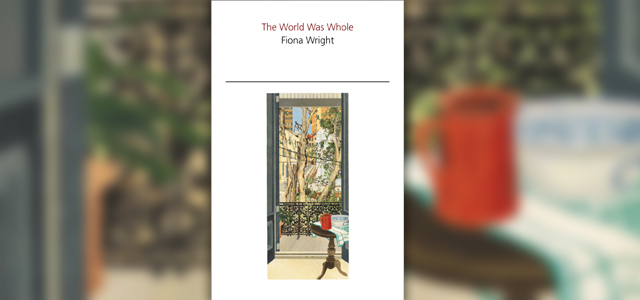Review: The World Was Whole by Fiona Wright,
Published by Giramondo
Often we don’t know what goes on inside homes and inside people. In The World Was Whole, a series of essays that become a kind of memoir, we are privy to the domestic and mental interiors of Fiona Wright, who from outside may seem a successful inner city type, an assured and talented, sometimes even feisty and formidable, writer and teacher, but who is also at times lonely and fragile, and debilitated by illness.
Some years ago Wright developed a chronic reaction to certain foods, which led to a form of anorexia. Unable to keep food down, the avoidance of proper meals altogether seems like an understandable strategy. But it of course knocks her around physically and mentally, wears her down slowly, and complicates her relationships. Such is her story that a reader might be moved to simply wanting to give her a hug.
There is contrast between her hospitalisations, collapses, tears, tiredness and frustration and her confident and wise writing. She is often eloquent where anger would be more understandable, although there are also the odd and despairing outbursts. Her writing is of course a form of therapy, a therapy that benefits us as well. The fact that the audience is remote probably helps with the flow and flowering of the writing.
It is not a miserable book. She writes well about joy, even when, she says, it is difficult for writers to write about joy. (Angry is easier.) The simple pleasures of warming sunshine and dogs chasing balls are heightened by the stretches of anxiety and distress in-between.
The book also chronicles some development in her understanding of her illness – what it is to live long term with illness, how it is not a withdrawal from living but a form of living. She writes that the metaphor of fighting illness can have unintended implications, and she cautions that our bodies are not necessarily battlefields, and having to live with illness is not necessarily defeat or surrender.
This is not to say that her illness is always the centre of her often beautiful narrative, even if it gnaws at each narrative she unfurls. The book is, amongst other things, also an attempt to understand the meaning of home, especially when one is without a partner or children, or one permanent dwelling. In her recounting of visits to cafes, galleries, bars and parks in inner suburban Sydney, she lets us in on the little interconnections that make up a sense of home. She notes that the circumference of home, what feels familiar to us, is usually quite small. In China, where she finds it hard to understand the basic assumptions underpinning a foreign society, but is relentlessly observant of the little routines that make up a neighbourhood, she realises that home often simply means knowing the rules.
She writes lovingly about the sadness of leaving houses and housemates and is angry about how the fluid nature of modern work leads to instability in housing and relationships. In her case this is all compounded by her illness, but this throws into greater relief the moments of community and the small, random acts of kindness that bring her often to tears.
The book is not intended to be didactic, but it might help us look twice at those around us, beyond the facades of completeness we often wear, and prompt us to our own acts of kindness and seizures of the small moments of joy.
Nick Mattiske blogs on books at coburgreviewofbooks.wordpress.com













